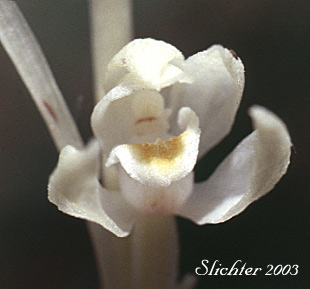Phantom Orchid
Cephalanthera austiniae
Synonyms: Chloraea austiniae, Eburophyton austiniae


 Characteristics:
Characteristics:
The phantom orchid indeed appears like a phantom when lit against a dark forest background, appearing bright white with the shaded parts disappearing into the dark background (See photo at right.) It is a saprophyte, deriving nutrition via association with microrhizal organisms from decaying matter in the forest floor. It is wholly white or greenish-white, and lacks green leaves. The erect stem is smooth and ranges from 20-50 cm tall. The whitish leaves are found on the stems where they are sheathing (except for the upper one or two).
The 5-20 flowers are racemose with the flower spike from 8-20 cm long. The bracts subtending ea;ch flower range from longer than the flowers (lower in the spike) to shorter near the top of the spike. The sepals and petals are mostly the same size and shape (elliptic-lanceolate and 10-20 mm long), with the lower lip being shorter and ringed with yellow where it leads into the basal sac (See photo above.).
The phantom orchid is found in damp mossy to dry soils in dark coniferous forests.
The phantom orchid is found in the Olympic and Cascade Mts. of Washington and Oregon, and is found as far south as southern California. It has also been found in west-central Idaho.